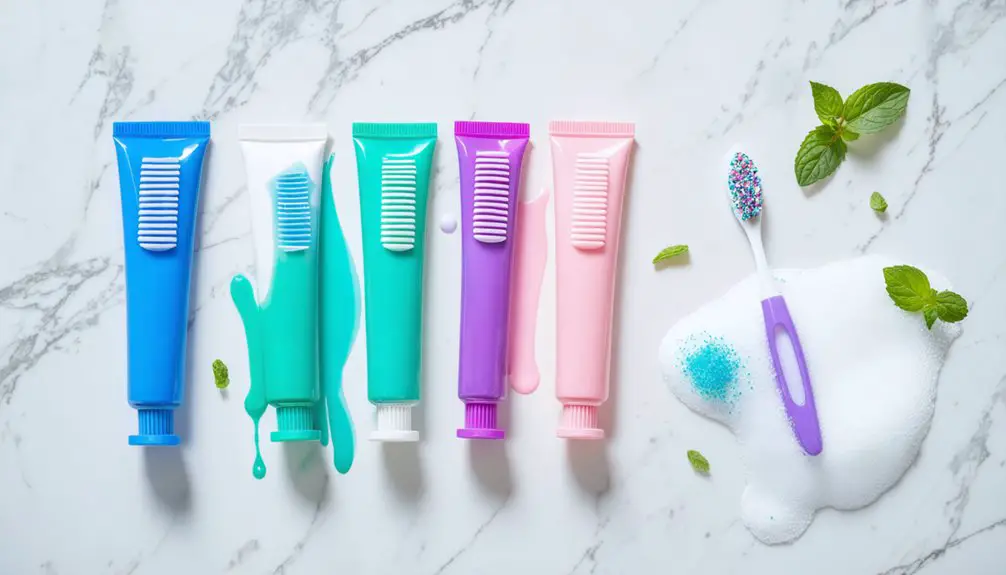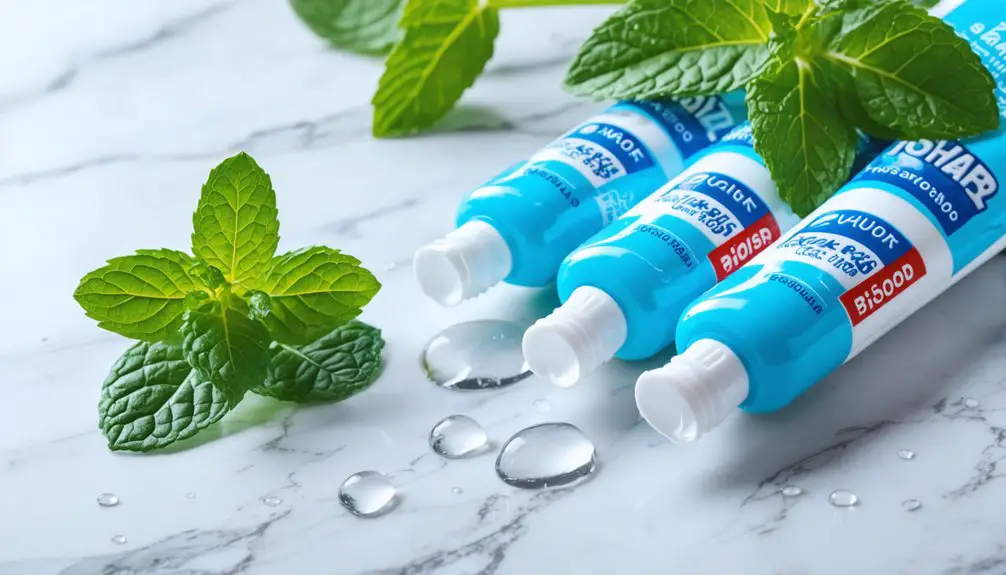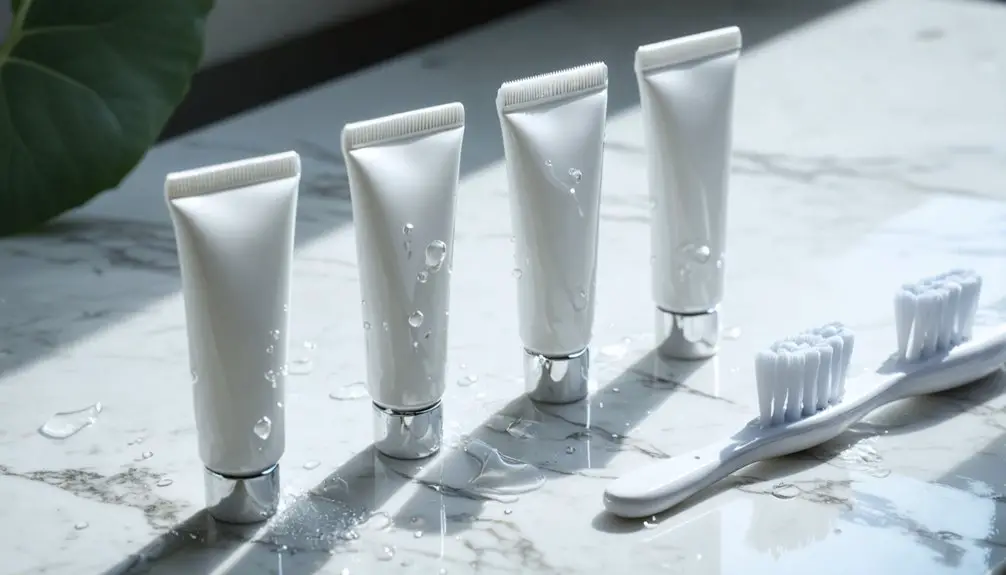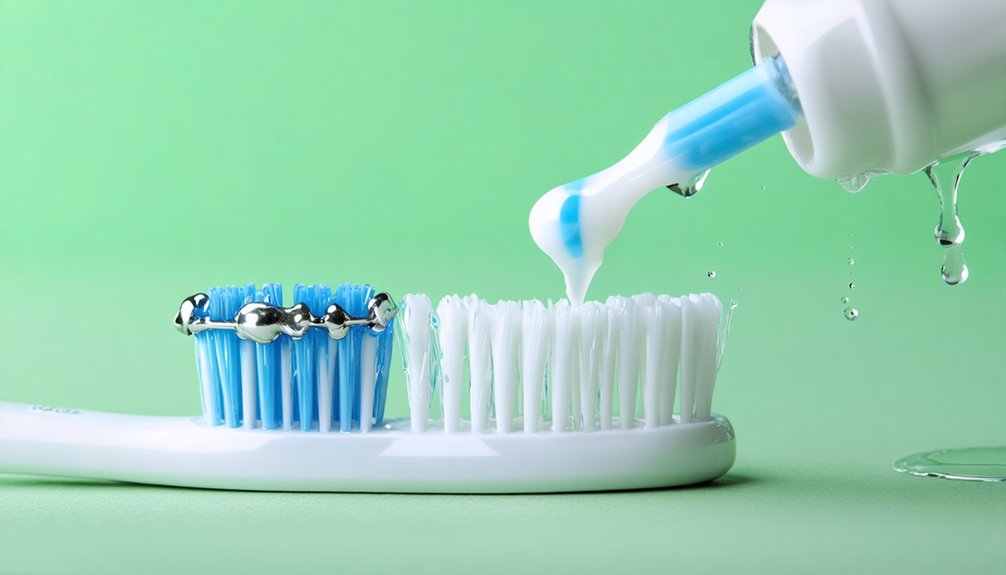You’ll find gentle yet effective fluoride-free options like Jack N’ Jill, Tom’s of Maine, and Hello Kids that naturally brighten your child’s smile. These toothpastes use safe ingredients like xylitol, baking soda, and plant extracts to remove surface stains while protecting developing teeth. Look for mild flavors that encourage regular brushing habits, and always use a small smear amount for children under 3. Discover how natural ingredients can transform your child’s oral care routine.
Key Takeaways
- Jack N’ Jill’s vegan formula combines natural flavors with xylitol for effective cavity prevention and gentle whitening.
- Tom’s of Maine and Hello Kids offer kid-friendly flavors with mild abrasives for natural stain removal.
- Dr. Bronner’s All-One toothpaste uses organic ingredients that safely brighten teeth while supporting sustainable practices.
- Burt’s Bees cranberry extract toothpaste promotes gum health while naturally removing surface stains.
- Baking soda-based natural toothpastes effectively whiten teeth without harsh chemicals or artificial ingredients.
Understanding Natural Teeth Brightening for Children
While many parents seek safe ways to brighten their children’s smiles, natural teeth whitening methods offer gentle alternatives to harsh chemical treatments.
Natural teeth whitening provides a gentler path to brighter smiles, helping parents avoid harsh chemicals while caring for their children’s dental health.
The American Academy of Pediatric Dentistry advises against professional whitening treatments until children reach age 14.
You’ll find that crunchy fruits and vegetables act as natural abrasives, helping remove surface stains while your child enjoys healthy snacks. Regular consumption of crunchy celery sticks can naturally clean teeth throughout the day. Incorporating dairy products strengthens enamel, creating a protective barrier against discoloration.
When considering homemade remedies, exercise caution with natural whitening agents. While baking soda and diluted hydrogen peroxide can be effective, they should be used sparingly to protect your child’s delicate enamel.
Focus instead on establishing consistent oral hygiene habits like proper brushing and flossing. Remember to limit acidic and sugary foods that can erode enamel, and encourage water consumption to help naturally rinse away stain-causing particles.
Best Kid-Friendly Fluoride-Free Toothpaste Brands
Parents seeking alternatives to traditional fluoride toothpaste can find several high-quality options designed specifically for children.
You’ll discover trusted brands like Jack N’ Jill, which offers vegan-friendly formulas with natural flavors and xylitol for cavity protection.
Tom’s of Maine and Hello Kids provide gentle toothpaste textures that won’t overwhelm sensitive mouths, while catering to your child’s flavor preferences with options like bubble gum and blue raspberry. Experts recommend using a small smear amount for children under age 3.
For environmentally conscious families, Dr. Bronner’s All-One toothpaste features organic ingredients and sustainable packaging. However, these options lack the cavity-fighting protection that fluoride provides.
Burt’s Bees rounds out the top choices with its cranberry extract formula that supports gum health.
These brands prioritize safe, swallow-friendly ingredients – perfect for toddlers still learning to brush – while avoiding harsh chemicals like SLS and artificial preservatives.
Safe Ingredients That Support Whiter Smiles
Natural ingredients can effectively brighten children’s smiles without compromising their dental health. When choosing natural whitening options, consider baking soda-based toothpaste, which safely removes surface stains while being gentle on young teeth.
You’ll also find malic acid, found in apples and strawberries, offers a safe way to break down stains naturally.
Support your child’s bright smile through dietary benefits by incorporating crunchy fruits and vegetables like apples, celery, and carrots into their meals. These foods act as natural tooth cleaners while chewing. For optimal results, use products containing hydrogen peroxide solutions to help eliminate harmful bacteria while whitening. According to experts, children should wait until age 14 or 15 before using any bleaching products.
Remember to serve water after meals to wash away particles and neutralize acids. While some natural remedies like lemon and fruit peels show promise, it’s best to stick with proven methods that won’t risk damaging your child’s delicate enamel.
Parent’s Guide to Choosing Natural Oral Care
Beyond achieving a bright smile, selecting the right oral care products for your child requires careful consideration of both safety and effectiveness.
When choosing natural toothpaste, carefully review ingredient labels to verify they’re non-toxic and specifically formulated for children’s delicate teeth and gums. Mild flavors help encourage consistent brushing habits in young children.
Look for products containing natural sweetness from xylitol, which can help protect against cavities while making brushing more enjoyable for your little one. Without fluoride, children need extra cavity protection through diligent oral hygiene practices.
Consider toothpaste with nano hydroxyapatite or essential oils that support enamel health without harsh chemicals. Your child’s specific needs, such as dry mouth or sensitivity, should guide your selection.
Remember to consult your pediatric dentist about proper brushing techniques and product recommendations based on your child’s cavity risk factors and oral health history.
Making the Switch to Natural Toothpaste Alternatives
When shifting to fluoride-free toothpaste, you’ll want to choose products enriched with proven cavity-fighting alternatives like xylitol and hydroxyapatite.
Making this toothpaste change smooth for your kids requires attention to their preferences and comfort. Start by introducing natural flavors your children enjoy, such as mint or fruit varieties. Using toothpaste with aloe vera extracts can provide soothing benefits for sensitive gums.
You’ll need to maintain consistent brushing routines while monitoring their oral health for any changes. Good brushing habits and limiting sugary foods are essential for cavity prevention when using natural toothpaste. Teaching your kids about the benefits of natural ingredients can help them embrace the switch with enthusiasm.
Remember to select formulas containing gentle abrasives like calcium carbonate or baking soda for effective plaque removal.
Natural antimicrobial ingredients such as tea tree oil and neem can help protect their teeth while supporting gum health. If you’re uncertain about the switch, consult your pediatric dentist for personalized guidance.
Frequently Asked Questions
How Often Should Children Brush With Fluoride-Free Toothpaste for Best Whitening Results?
Like stars that shine twice daily, you’ll want your child to brush after breakfast and before bed, with optional brushing after meals for enhanced whitening techniques and better brushing frequency.
Can Fluoride-Free Toothpaste Effectively Prevent Tooth Decay in Cavity-Prone Kids?
While natural ingredients can help, fluoride-free toothpaste isn’t as reliable for cavity prevention in high-risk kids. You’ll want to consult your dentist about more effective options for protecting their teeth.
At What Age Should Children Start Using Natural Whitening Toothpaste?
You can introduce natural whitening toothpaste with gentle natural ingredients around age 8, once your child reliably spits while brushing and has developed good oral habits supporting children’s dental health.
Do Fluoride-Free Toothpastes Have a Shorter Shelf Life Than Conventional Ones?
Like Schrödinger’s cat, it’s not a simple yes or no – your fluoride-free toothpaste’s shelf life depends on its specific ingredient stability. You’ll need to check each product’s unique expiration guidance.
Should Children Rinse After Using Natural Toothpaste, or Let Ingredients Remain?
You’ll want your child to lightly rinse after using natural toothpaste, especially if they’re under 6. This balances ideal ingredient absorption with safety, preventing excess swallowing while maintaining some benefits.
References
- https://ca.laifentech.com/blogs/news/best-fluoride-free-toothpaste
- https://www.agapepediatricdentistry.com/post/the-ultimate-guide-to-picking-the-best-toothpaste-for-kids-tips-for-little-ones-big-kids-and-teen
- https://www.target.com/c/kids-oral-care/dye-free/-/N-e5tr3Zxc754
- https://www.consumerreports.org/health/dental-oral-care/best-toothpastes-for-kids-a7638580157/
- https://gimmethegoodstuff.org/blogs/guides-and-product-reviews/the-best-non-toxic-toothpaste-guide
- https://www.palmettofamilydental.com/blog/whitening-kids-teeth-naturally-using-home-remedies
- https://www.littledentalpediatricdentistry.com/safe-ways-to-brighten-your-child-smile-naturally/
- https://www.thesuperdentists.com/teeth-whitening-for-kids-how-to-whiten-kids-teeth-safely/
- https://www.joyfulsmilespediatricdentistry.com/some-natural-ways-to-brighten-your-childs-teeth/
- https://www.pleasantfamilydentistry.com/blog/6-natural-ways-to-whiten-your-teeth



